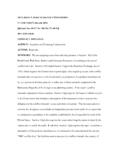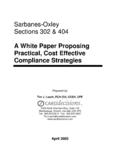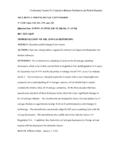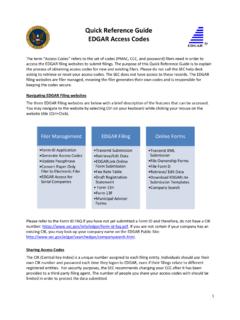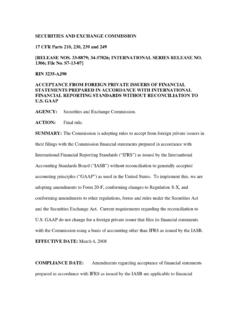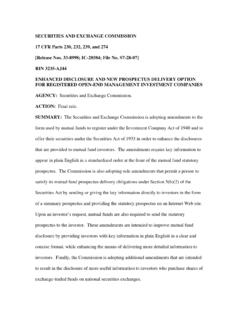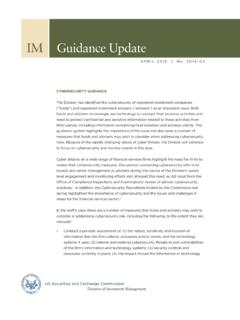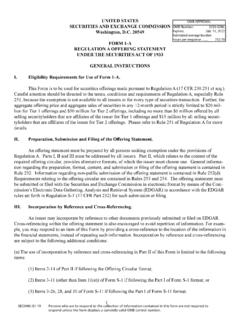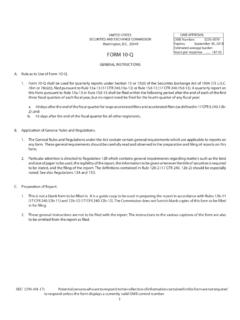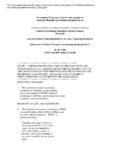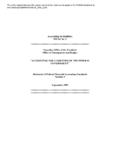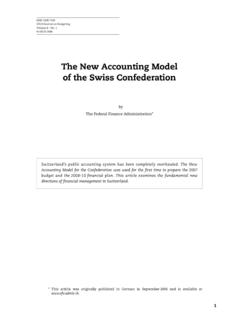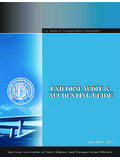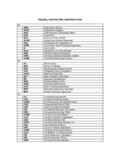Transcription of Study on Mark-To-Market Accounting - SEC.gov
1 Report and Recommendations Pursuant to Section 133 of the Emergency Economic Stabilization Act of 2008: Study on Mark-To-Market Accounting OFFICE OF THE CHIEF ACCOUNTANT DIVISION OF CORPORATION FINANCE UNITED STATES SECURITIES AND EXCHANGE COMMISSION This is a report by the Staff of the Securities and Exchange Commission. The Commission has expressed no view regarding the analysis, findings, or conclusions contained herein. iTABLE OF CONTENTS Commonly-Used Abbreviations viii Executive Summary 1 I. Introduction 11 A. How this Study Fulfills the Statutory Mandate 11 1. Statutory Mandate 11 2. Context for this Study 11 3. Approach to this Study 12 4.
2 Structure of this Study 14 B. The Financial Reporting Framework 15 1. Balance Sheet 16 2. Income Statement 17 3. Other Basic Financial Statements 18 4. Notes to the Financial Statements, Management s Discussion and Analysis of Financial Condition and Results of Operations, and Other Disclosures 19 C. Other Considerations 20 1. Role of Accounting in Prudential Oversight 20 2. International Considerations 20 D. Background Information on Fair Value Accounting 22 1. Definition of Fair Value 22 a. GAAP 22 b. IFRS 23 2. Application of Fair Value Accounting 24 a.
3 How Fair Value Impacts Accounting for Financial Instruments 25 i. GAAP 25 ii. IFRS 31 b. How Fair Value Impacts Accounting for Non-Financial Instruments 32 i. GAAP 32 ii. IFRS 33 3. Historical Context for Fair Value Accounting 34 4. Other Measurement Bases 38 a. Description of Other Measurement Bases 38 b. Consideration of Measurement Attributes 40 iiII. Effects of Fair Value Accounting standards on Financial Institutions Balance Sheets 43 A. Methodology for Studying Effects of Fair Value Accounting standards 43 B. Empirical Findings from this Study on Effects of Fair Value Accounting standards 45 1.
4 Assets 46 a. Significance of Assets Measured at Fair Value 46 i. Percentage of Assets Measured at Fair Value 46 ii. Percentage of Assets Measured at Fair Value through Income 49 iii. Distribution of Issuers by Percentage of Assets Measured at Fair Value 52 iv. Use of Fair Value Option 54 v. Comparison of Percentage of Assets Measured at Fair Value Before and After Adoption of SFAS No. 157 and SFAS No. 159 57 b. Nature of Assets Measured at Fair Value on a Recurring Basis 58 c. Classification of Assets in Fair Value Hierarchy 60 i. Fair Value Hierarchy Classification over Time 61 ii.
5 Distribution of Issuers by Percentage of Assets Classified as Level 3 63 2. Liabilities 65 a. Significance of Liabilities Measured at Fair Value 65 i. Percentage of Liabilities Measured at Fair Value 65 ii. Distribution of Issuers by Percentage of Liabilities Measured at Fair Value 68 iii. Use of Fair Value Option 70 iv. Comparison of Percentage of Liabilities Measured at Fair Value Before and After Adoption of SFAS No. 157 and SFAS No. 159 72 b. Nature of Liabilities Measured at Fair Value on a Recurring Basis 74 c. Classification of Liabilities in Fair Value Hierarchy 75 i. Fair Value Hierarchy Classification over Time 75 ii. Distribution of Issuers by Percentage of Liabilities Classified as Level 3 78 3.
6 Equity 79 a. SFAS No. 157 Adoption 79 b. SFAS No. 159 Adoption 82 c. Accumulated Other Comprehensive Income 84 iii 4. Income Statement 86 a. Recurring Fair Value Measurements 87 i. Recurring Mark-To-Market Adjustments 87 ii. Level 3 Fair Value Measurements 89 iii. Impact of Changes in Creditworthiness in Measuring Liabilities 91 b. Non-Recurring Fair Value Measurements (Impairments) 92 i. All Impairments 92 ii. Other-than-Temporary Impairments on Securities 93 iii. Goodwill Impairment 94 c. Key Income Statement Drivers Unrelated to Fair Value Measurements 94 d. Conclusions 95 III.
7 Impact of Fair Value Accounting on Bank Failures in 2008 97 A. Methodology for Studying Bank Failures 97 B. Regulatory Framework Governing Bank Failures 99 1. Capital Adequacy Guidelines 99 2. Reported Capital Status for 2008 Failed Banks 101 C. How Fair Value Accounting Affects Reporting under GAAP for Banks 104 1. Aggregate Failed Banks < $1 Billion of Total Assets 105 2. Aggregate Failed Banks > $1 Billion, but < $10 Billion of Total Assets 107 3. Failed Banks > $10 Billion of Total Assets 109 a. Washington Mutual 109 b. IndyMac 111 c.
8 Downey Savings and Loan 113 D. Interaction Between Regulatory Capital and GAAP 114 E. Analysis of Causes of Declines in Failed Bank Capital 117 1. Aggregate Failed Banks < $1 Billion of Total Assets 118 2. Aggregate Failed Banks > $1 Billion, but < $10 Billion of Total Assets 119 3. Failed Banks > $10 Billion of Total Assets 120 a. Washington Mutual 121 ivb. IndyMac 123 c. Downey Savings and Loan 125 F. Evaluation of the Circumstances Surrounding Each Bank Failure 125 1. Failed Banks < $1 Billion of Total Assets 126 2.
9 Failed Banks > $1 Billion, but < $10 Billion of Total Assets 128 3. Failed Banks > $10 Billion of Total Assets 130 a. Washington Mutual 133 b. IndyMac 134 c. Downey Savings and Loan 135 G. Impact of Fair Value Accounting on Other Distressed Financial Institutions 136 IV. Impact of Fair Value Accounting on the Quality of Financial Information Available to Investors 139 A. Investor and User Views About the Use of Fair Value Measurements 139 1. Comment Letters and Other Public Statements 139 a. Representative Survey of Comment Letters 140 b.
10 Other Public Statements 143 c. Observations 144 2. Common Themes in Individual Analyst Reports on Fair Value Measurements 145 B. Views Presented by Participants at Recent SEC Fair Value Roundtables 146 1. July 9 Roundtable 146 a. Usefulness of Fair Value and Related Disclosures in Current market Conditions 146 b. Application of Fair Value Accounting 147 c. market Behavior Effects of Fair Value Accounting 147 d. Impact of Non-Performance Risk on Fair Value of Liabilities 148 2. October 29 Roundtable 148 a. Usefulness of Fair Value Accounting 148 b.

